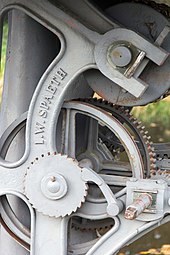Johann Wilhelm Spaeth
Johann Wilhelm Spaeth (* 1786 in Ismannsdorf ; † 1854 in Nuremberg ) was a German technician , inventor and, as an industrialist, founder of the first Nuremberg machine factory in the 19th century.
Life

After an apprenticeship as a miller, Johann Wilhelm Spaeth worked as a mill boy and as a works manager at the pipe mill. On his subsequent journeys across Germany , he got to know the technology of English machines. After returning home, Spaeth first worked as a machine foreman in a Schwabach cloth factory, then he worked as a mill doctor with the repair and construction of mills .
In 1822 Johann Wilhelm Spaeth opened his own mechanics workshop in the Nuremberg district of Wöhrd. Due to the good order situation, it soon became too small and in 1825, together with his brother Johann Michael Spaeth, he bought the mill hammer mill located at the outflow of the Dutzendteich . Within ten years, Wilhelm Spaeth rebuilt the factory based on the American model and the “first Bavarian machine factory” was created. In 1835 the factory included a turning shop, locksmith's shop, forge and a joinery. In the same year the first locomotive with the name Adler for the first German railway company , the Ludwigseisenbahn, was assembled in the factory halls of Spaeth . He also ensured duty-free transport of the individual parts to Nuremberg by acting as the recipient and describing the steam locomotive as a model for German industry.
Since he was not interested in mass production , his factory grew slowly. Shortly before his death in 1854, around 140 people worked in the factory. When Spaeth realized that there would be no progress without mass production, he lacked the capital to expand.
In 1854 Johann Wilhelm Spaeth fell victim to an epidemic of cholera in Nuremberg , as one of the first of 325 people.
The machine factory was initially continued by Spaeth's son-in-law Johannes Falk. Falk also belonged to the more cautious entrepreneurial type, but the reviving economy was gracious to Spaeth & Co and helped the company to achieve enormous growth. The number of employees grew to 400 by 1860. The upswing continued until the Nazi party rally grounds were built. Conflicts of interest with the plans of the National Socialists led to the decline of the company. Company property had to be sold far below its value, government contracts were withdrawn and lucrative armaments contracts were given to other companies. The factories were destroyed in the Second World War , which ultimately led to the de-registration of the business in 1960. What remained are some ruins , the factory owner's villa of the Spaeth family on Dutzendteichstraße , built in 1874, and the half-ruined "Hammerbachersche Villa" on Schultheissallee. (Hans Hammerbacher was another son-in-law of Spaeth.) Not far from Nuremberg's St. Peter's Church, Wilhelm-Spaeth-Strasse commemorates the inventor.
Works
The new winch built by Spaeth in 1825 to fix the English greeting by Veit Stoss in the Lorenz Church is still in operation today.
Spaeth designed parts for the first steam locomotive in Germany, known as the "Adler", which drove from Nuremberg to Fürth on December 7, 1835 , and was involved in assembling the locomotive, which was supplied in over a hundred individual parts by the English locomotive builder Robert Stephenson .
For the construction of the Ludwig-Danube-Main Canal , which connected the Danube with the Main , he developed special dredging machines, water augers (for pumping water), loading cranes, locks and weirs .
Some machines are exhibited in the Museum of Industrial Culture.
literature
- Pascal Metzger: machine factory, iron foundry, and bridge building institute Johann Wilhelm Spaeth (1821-1969). Structure and strategy of a Nuremberg family company . Schmidt Verlag Neustadt an der Aisch 2011. ISBN 978-3-87707-820-4 .
- Pascal Metzger: Spaeth, Johann Wilhelm. In: New German Biography (NDB). Volume 24, Duncker & Humblot, Berlin 2010, ISBN 978-3-428-11205-0 , p. 612 f. ( Digitized version ).
- Andreas Curtius (ed.): Art and iron. From the collections of the Nuremberg industrial family Spaeth - Falk - Hammerbacher. Publication series of the museums of the city of Nuremberg 2018. Volume 16 (available in the museum shop )
- Uta Trott and Klaus-Rüdiger Trott: Johann Wilhelm Spaeth 1786 - 1854. From miller to industrial pioneer. Schmidt Verlag Neustadt an der Aisch 2018. ISBN 978-3-87707-116-8 .
Web links
- Marlene Townson: Essay on Spaeth.
- Villa Spaeth
- Museum of industrial culture
| personal data | |
|---|---|
| SURNAME | Spaeth, Johann Wilhelm |
| BRIEF DESCRIPTION | German technician, inventor, founder of the first Nuremberg machine factory |
| DATE OF BIRTH | 1786 |
| PLACE OF BIRTH | Ismannsdorf |
| DATE OF DEATH | 1854 |
| Place of death | Nuremberg |


